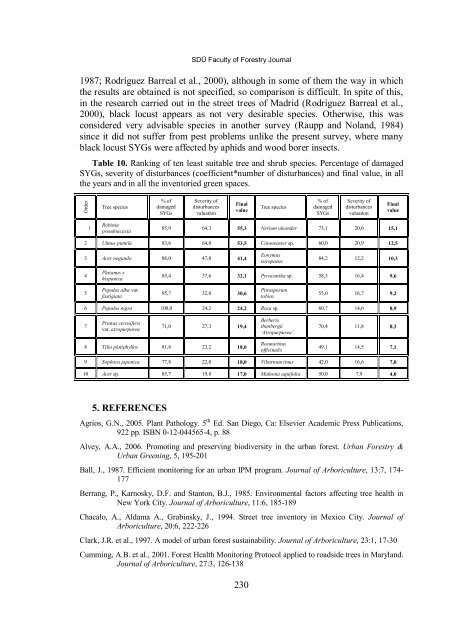sdu faculty of forestry journal special edition 2009 - Orman Fakültesi
sdu faculty of forestry journal special edition 2009 - Orman Fakültesi
sdu faculty of forestry journal special edition 2009 - Orman Fakültesi
Create successful ePaper yourself
Turn your PDF publications into a flip-book with our unique Google optimized e-Paper software.
SDÜ Faculty <strong>of</strong> Forestry Journal<br />
1987; Rodríguez Barreal et al., 2000), although in some <strong>of</strong> them the way in which<br />
the results are obtained is not specified, so comparison is difficult. In spite <strong>of</strong> this,<br />
in the research carried out in the street trees <strong>of</strong> Madrid (Rodríguez Barreal et al.,<br />
2000), black locust appears as not very desirable species. Otherwise, this was<br />
considered very advisable species in another survey (Raupp and Noland, 1984)<br />
since it did not suffer from pest problems unlike the present survey, where many<br />
black locust SYGs were affected by aphids and wood borer insects.<br />
Table 10. Ranking <strong>of</strong> ten least suitable tree and shrub species. Percentage <strong>of</strong> damaged<br />
SYGs, severity <strong>of</strong> disturbances (coefficient*number <strong>of</strong> disturbances) and final value, in all<br />
the years and in all the inventoried green spaces.<br />
Order<br />
1<br />
Tree species<br />
Robinia<br />
pseudoacacia<br />
% <strong>of</strong><br />
damaged<br />
SYGs<br />
Severity <strong>of</strong><br />
disturbances<br />
valuation<br />
Final<br />
value<br />
230<br />
Tree species<br />
% <strong>of</strong><br />
damaged<br />
SYGs<br />
Severity <strong>of</strong><br />
disturbances<br />
valuation<br />
Final<br />
value<br />
85,9 64,3 55,3 Nerium oleander 73,1 20,6 15,1<br />
2 Ulmus pumila 83,6 64,0 53,5 Cotoneaster sp. 60,0 20,9 12,5<br />
3 Acer negundo 88,0 47,0 41,4<br />
4<br />
5<br />
Platanus x<br />
hispanica<br />
Populus alba var.<br />
fastigiata<br />
Eonymus<br />
europaeus<br />
84,2 12,2 10,3<br />
85,4 37,6 32,1 Pyracantha sp. 58,3 16,4 9,6<br />
95,7 32,0 30,6<br />
Pittosporum<br />
tobira<br />
55,0 16,7 9,2<br />
6 Populus nigra 100,0 24,2 24,2 Rosa sp. 60,7 14,6 8,9<br />
7<br />
Prunus cerasifera<br />
var. atropurpurea<br />
71,0 27,3 19,4<br />
8 Tilia platiphyllos 81,8 23,2 18,0<br />
Berberis<br />
thunbergii<br />
‘Atropurpurea’<br />
Rosmarinus<br />
<strong>of</strong>ficinalis<br />
70,4 11,8 8,3<br />
49,1 14,5 7,1<br />
9 Sophora japonica 77,8 22,0 18,0 Viburnum tinus 42,0 16,6 7,0<br />
10 Acer sp. 85,7 19,8 17,0 Mahonia aquifolia 50,0 7,9 4,0<br />
5. REFERENCES<br />
Agrios, G.N., 2005. Plant Pathology. 5 th Ed. San Diego, Ca: Elsevier Academic Press Publications,<br />
922 pp. ISBN 0-12-044565-4, p. 88<br />
Alvey, A.A., 2006. Promoting and preserving biodiversity in the urban forest. Urban Forestry &<br />
Urban Greening, 5, 195-201<br />
Ball, J., 1987. Efficient monitoring for an urban IPM program. Journal <strong>of</strong> Arboriculture, 13:7, 174-<br />
177<br />
Berrang, P., Karnosky, D.F. and Stanton, B.J., 1985. Environmental factors affecting tree health in<br />
New York City. Journal <strong>of</strong> Arboriculture, 11:6, 185-189<br />
Chacalo, A., Aldama A., Grabinsky, J., 1994. Street tree inventory in Mexico City. Journal <strong>of</strong><br />
Arboriculture, 20:6, 222-226<br />
Clark, J.R. et al., 1997. A model <strong>of</strong> urban forest sustainability. Journal <strong>of</strong> Arboriculture, 23:1, 17-30<br />
Cumming, A.B. et al., 2001. Forest Health Monitoring Protocol applied to roadside trees in Maryland.<br />
Journal <strong>of</strong> Arboriculture, 27:3, 126-138








